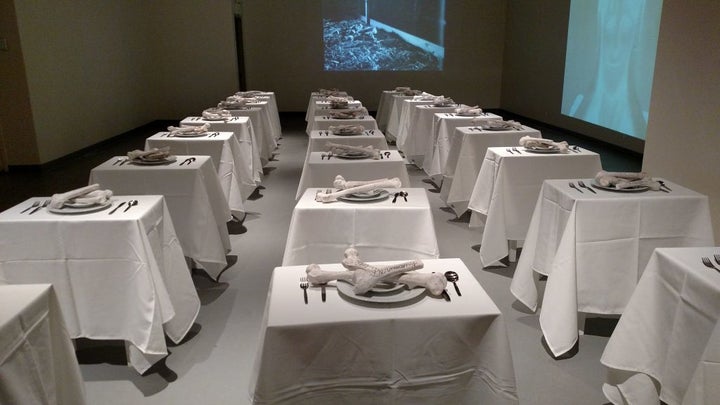
Bug’s exhibit at the Dairy Arts Center
My brain thinks it’s running the Aimee Show, which is further proof of how clueless it is.
I think (ooh, get it) my thoughts are my most inferior type of intelligence.
Smarter is my emotional intelligence. There are so many things — infinite things — that my conscious thoughts can’t wrap themselves around that I can understand on an emotional level. Like the very concept of infinite things. I can look into the night sky and sense the eternity of the universe, yet my thought patterns short circuit when I try to do my own taxes. I mean, my brain can’t even exactly understand what emotions are. Chemical responses that come from the brain? Typical brain. Always wanting credit.
My brain is easily trained and manipulated and overly concerned with protecting itself, so it just blacks out when things get too tough. It’s like a fainting goat, freezing and tipping over in paralysis at the sound of a sudden clap.
I went to a refugee camp in Uganda (featured in the film, “Sauti,” at the Boulder International Film Festival) and my brain completely stalled out and began smoking at the question of what to do about the refugee crisis. My thoughts: Derrrrr. My emotions: impassioned and unable to not try to help in some way.
Maybe this is a survival mechanism, like the freeze response in prey animals. But sometimes, you have to be able to move — to fight or flight — in order to survive.
Which brings us to art.
Art is a magical conduit through which concepts are transmitted directly into the emotional intelligence center of the human. So even when the mind just can’t even, you can still stay engaged and not shut down. This kind of communication transcends dogma, politics and other beliefs (ahem, all of which live in that gosh-diggity-darn brain). In that, art can connect people of all backgrounds on a higher level — one that sidesteps over the lump of thoughts all passed out and awkward on the floor and has the potential to spark more creation, or if needed, change.
I don’t want to think about genocide. I don’t.
It’s too painful, and I feel powerless. There’s so much I don’t understand. But I can’t ignore it either — the fact that it “continues at a rapid pace today.” That’s according to a Denver-based artist who goes simply by Bug.
I saw Bug’s work on exhibit at Boulder’s Dairy Arts Center. It was unlike anything the Dairy has ever presented before.
It was a series of tables set with white table clothes, white plates and silverware. At first glance, it looked like a dinner party. But as I walked closer, I saw the plates were holding stacked bones, marked with the name of a human genocide over history. The display was jarring in its juxtaposition to what we’re used to associating to a dinner table: community connection, bonding, nourishing, filling up.
One plate was empty. That held the seat for the next genocide.
The exhibit was called “Signature.”
“His question is will we be moved enough to act, even though it may not affect us personally?” asked Bill Obermeier, executive director of the Dairy. “Or are we wired this way? Is this the signature of our species?”
Even the question alone is shocking, he said.
Over the past few years, the Dairy Center has been opening up more space for art about social issues. That’s because the center sees the power of art, Obermeier said.
“It’s able to create an emotional connection in a way that a political discourse can’t. Whereas politics can create divisions, art bridges the divide by getting human emotions engaged in the issue,” he said.
This article originally appeared on TravelBoulder.com. Visit TravelBoulder.com for the inside guide to visiting Boulder, Colorado, and other weird stories about the strangest city in America.
